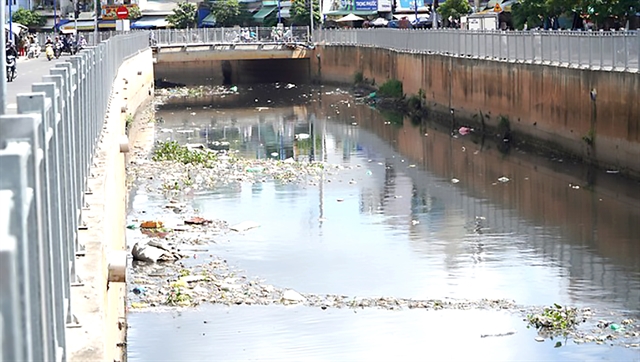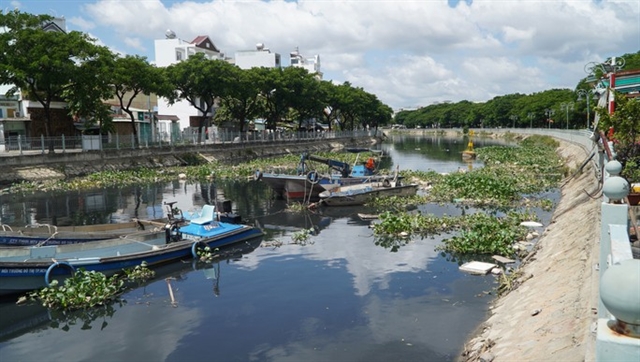 Environment
Environment

 |
| Nước Đen Canal in HCM City is constantly littered with trash. — Photo nld.com.vn |
HCM CITY — Despite renovation projects that have been carried out, many canals and streams in HCM City are experiencing recurrent pollution problems, forcing locals and experts to call for radical and sustainable solutions.
Nghiêm Thị Phượng, a Bình Tân District resident who has been running her shop near Nước Đen Canal for nearly a decade, said that she “has gotten used to how polluted the water here is.”
Despite having undergone a renovation project, the signs of pollution are becoming more evident than ever.
The Nước Đen Canal renovation project was initiated at the beginning of 2020 with a total investment of VNĐ629 billion (US$26.1 million) and was completed after two years.
Phượng said: “About a year ago, when the project was just finished, we were all so happy to see how clean the water was.
“But recently, it has turned mucky once again with an indescribable smell.”
The local vendor said that if no immediate actions are taken, the stream will be once again become badly polluted.
The Người Lao Động (Labourer) newspaper reported that public area cleaners regularly pick up trash from the canal, but more garbage keeps being thrown into the water.
Meanwhile, the Tân Hóa-Lò Gốm Canal that travels through Districts 6, 11 and Tân Phú is also in the same situation.
Đàm Tấn Lợi, a local resident in District 6, said: “When it was first renovated, this canal was so clean and nice.
“Now it has gotten worse. There is too much trash, and while cleaners are working every day to remove waste from the water, it’s only a short while before the stream is mucky again.
“If we want the canal clean, then wastewater treatment is a must.”
Root causes
According to Dr Nguyễn Đinh Tuấn, former dean of HCM City University of Natural Resources and Environment, the recurrent pollution in numerous urban canals is because wastewater from residential and industrial areas is not separated from the streams.
For example, the Tân Hóa-Lò Gốm Canal renovation project focused on building embankments, relocating slums and repairing roads on the two banks. However, there are still other sources of pollution, he said.
 |
| Water in Tân Hóa-Lò Gốm Canal is murky with a strong odour. — Photo nld.com.vn |
In the case of Nước Đen Canal, wastewater also goes through this stream before arriving at Bình Hưng Hòa water treatment plant.
Dr Tuấn added that HCM City currently has only two operating water treatment facilities.
These are Bình Hưng Hòa and Bình Hưng plants, whose capacity is 30,000 cubic metres and 140,000 cubic metres a day, respectively.
This means that only a modest percentage of urban wastewater is treated, while the remaining amount becomes a challenge to keeping the canals clean.
Dr Nguyễn Quốc Bình, former deputy director of the Biotechnology Centre of HCM City, said that there are two main reasons for the pollution in the city’s streams and canals.
They are the lack of wastewater collection and treatment systems in old residential areas, and the sewage discharge from small-scale industrial zones such as Lê Minh Xuân, Tân Bình and Vĩnh Lộc.
Dr Bình added that a majority of wastewater treatment facilities in HCM City industrial zones are deteriorating. Sewage processed through these systems can even kill microorganisms and algae when released into the environment.
“This leads to the situation where multiple canals are repeatedly polluted, their water turns black and has a strong odour,” said Dr Bình.
Actions needed
To radically address canal pollution in the city, Dr Bình said that new wastewater collection and treatment systems need to be soon put into operation.
In addition, it is necessary to issue standard regulations for wastewater treatment facilities in industrial zones, and monitor the quality of sewage discharged from all production areas.
Dr Bình believed that relocating small-scale industrial zones to the city’s outskirts, which was done decades ago, was only a temporary measure that moved the pollution source from one location to another.
“These areas are only economically beneficial to around 100 households but affect the living environment of millions of HCM City residents,” Bình said.
“Therefore, the city needs to take more suitable approaches, such as grouping them into a standard industrial zone.”
Dr Tuấn pointed to the case of Nhiêu Lộc-Thị Nghè Canal, which uses the underground sewer system to collect wastewater, then dilute it with the Sài Gòn River.
While it is not a thorough solution, the canal has managed to end the sources of pollution from residential areas and small-scale industrial zones, thereby preventing recurrent contamination. — VNS




